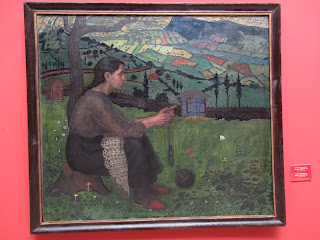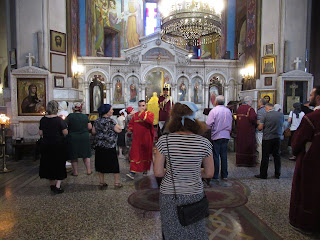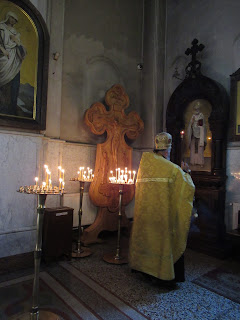We spent more than three hours first thing dealing with the B&B because we had reserved what the B&B advertised was a 323 sq. ft. room and the room we were given was less than 200 sq. ft. It was complicated by the fact that no one at the property spoke any English and they had to bring someone in who did. He explained the B&B didn't have the room they advertised. The property said it was booking.com's fault and, when I got through to booking.com, their rep insisted it was the B&B's fault. It wouldn't have mattered as much if we weren't staying for six nights then plus another night in another couple of weeks.
This was the first time that booking.com failed to help us find another property when a reservation went awry through no fault of our own. That was particularly disconcerting when we have made 99% of all our reservations for all of our travels with booking.com because of their high commitment to customer service and because of our past experience with their customer service.
Fortunately, while I was trying to iron things out with booking.com, Steven found another hotel that had an apartment with a small kitchen, was in a better location and I was able to negotiate a lower price on the spot and it had what can only be described as character! The ratings weren't nearly as good as our initial stay but look where that got us, huh!
We both figured all's well that ends well and were finally ready to explore Tblisi, the capital of Georgia, by doing our own walking tour. We have been on metros all over the world but never one as ugly as Tblisi's. When we got on the escalator, we felt like we were entering the bowels of the earth and would never see sunlight again. We couldn't even see the woman staffing the tiny booth at the bottom for at least five minutes though it seemed far longer than that! I reckon monitoring for potential accidents or mechanical breakdowns on the escalators must be the most boring job in the world and that's why so many of the booth attendants we saw over the next five days were either asleep or paying more attention to their phones than to what was going on in the escalators.
When we finally did see the light of day again, we saw the monument to, and the main street named after, Shota Rustaveli, a famous medieval Georgian poet. The 1.5km long street was laid out with elegant and important buildings by the Russians in the 19th century.
An informal souvenir market was taking place on the steps of the Academy of Sciences.
We didn't need any daggers that day, however so walked on down Rustaveli!
We have never seen a Wendy's outside North America before. I would love to know if you have.
Across the street, the Moorish-style Opera & Ballet Theater caught our eye so we walked over to take a closer look.
Glad we did because then we were able to see this adorable little statue! In our ensuing days in Tblisi, we saw more little statues, the likes of which we'd never seen before.
On the side of the theater was a pretty fountain with statues of ballerinas. Of course, the fountain stopped just when I was ready to snap the photo!
Thanks to Steven's having spent hours and hours before we left home downloading all the sites we hope to visit onto maps.me for each city we're visiting this trip, he was able to lead us through a maze of side streets to the Dry Bridge Market, that I'd read was especially good on the weekends. It was only a couple of days ago that we finally learned that all these horns being sold at the market and on the street were actually used for pouring wine in. The key, we were told, was that everyone who had one at a table had to drink all the contents at once because of course the horns couldn't be placed back on the table without the rest of the wine spilling on the table! I wonder how you say Bottoms Up in Georgian!
This folk instrument was new to us.
The market was so huge and on several levels so we just concentrated in one area of the market.
Many people were selling scarves that looked like they were felted and also had 'holey' spots, again something that was new to us. They were unusual but it was such a hot, hot day, I couldn't begin to think of getting something warm like that.
Soviet memorabilia, china and silverware were also popular items for sale in the open-air flea market section of the market.
Tbilisi must have a lot of aspiring painters as there was lots of art to look at.
More drinking vessels, we now know!
Back again on Rustaveli, we stopped in at the National Gallery, a building that was constructed in 1888 by order of Alexander III to "represent the glory of the Russian Army." The so-called Temple of Glory existed until 1914 and became the home of Georgia's foremost painters a few years later.
As was the case when we toured the National Gallery in Armenia's capital, we let Lonely Planet guide us to the most famous Georgian painters at this gallery. They included David Kakabadze:
Lado Gudiashvili:
Niko Pirosmanashvili:
It didn't take us long to wander through the 'national gallery' as the permanent collection of its nation's painters only took up two rooms on the upper floor. A small temporary exhibition was on the main floor. Perhaps many years down the line, there will be a greater representation of Georgian art to showcase.
Lil Red: We also had a very tough time deciphering this information at the gallery because of the alphabet!
Adjacent to the gallery was Kashveti Church.
We immediately realized that in Georgian Orthodox churches, unlike the Armenian Apostolic churches we had toured all over Armenia, it was customary and even required really for women to wear scarves to cover their hair and dress very modestly. Men must always have their legs covered and also adhere to a specific dress code. Fortunately, there is always a box of scarves and wraps available at the entrance of every Georgian church for people to borrow what they need when they enter.
We didn't realize we had timed it so that a service was taking place as we arrived.
I don't know the correct religious term to use but these 'men' were chanting as part of the service. I know they weren't Orthodox priests as all the ones we've seen are far older, dress in black and seem to always have a mini pony tail.
We watched as the priest walked around the entire interior of the church, waving his incense burner and praying at most icons.
This striking building on Rustaveli was Georgia's Parliament until 2012 when the seat of government was moved to the western Georgian city of Kutaisi where I am writing this post from and where we saw the 'new' Parliament today. The former building was where 19 Georgian hunger strikers died at the hands of Soviet troops in 1989 and the site of the Rose Revolution in November, 2003, with the peaceful pro-Western change of power.
Particularly exquisite were the detailed gold items from Cochis in western Georgia.
This 15th century silk Holy Shroud was also a fabulous work of art.
This intricate 11th century gate once adorned the front of a church in western Georgia.
The top floor was dedicated to the Museum of Soviet Occupation which lasted from 1921-1991.
The first panel provided an incomplete list of public figures and citizens who were shot during that dark period in Georgia's history.
Having just spent so much time at the Armenian Genocide Memorial and Museum in Yerevan, neither of us wanted to dwell on the Soviet chapter in Georgia's history.
Much more lighthearted was the museum's display of Tibetan Thangkas, Tibetan Buddhist paintings on cotton and silk applique that serve as important teaching tools depicting Buddha's life. We shouldn't have been surprised to see such a good collection of Eastern art as Tbilisi's location commanded a crossing of the Mtkvari River on age-old trade routes between Asia and Europe.
This Chinese one was from the 18th or 19th century.
20th century Indian wooden and textile umbrella:
Chinese 19th century silk robe:
Imagine wearing this 17th century Chain Mail Shirt with riveted steel rings and gemstones!
Bronze heads from the 2nd and 1st centuries BC:
Steven wanted his photo taken with all these skulls from Georgia's Stone Age!
This was the first time that booking.com failed to help us find another property when a reservation went awry through no fault of our own. That was particularly disconcerting when we have made 99% of all our reservations for all of our travels with booking.com because of their high commitment to customer service and because of our past experience with their customer service.
Fortunately, while I was trying to iron things out with booking.com, Steven found another hotel that had an apartment with a small kitchen, was in a better location and I was able to negotiate a lower price on the spot and it had what can only be described as character! The ratings weren't nearly as good as our initial stay but look where that got us, huh!
We both figured all's well that ends well and were finally ready to explore Tblisi, the capital of Georgia, by doing our own walking tour. We have been on metros all over the world but never one as ugly as Tblisi's. When we got on the escalator, we felt like we were entering the bowels of the earth and would never see sunlight again. We couldn't even see the woman staffing the tiny booth at the bottom for at least five minutes though it seemed far longer than that! I reckon monitoring for potential accidents or mechanical breakdowns on the escalators must be the most boring job in the world and that's why so many of the booth attendants we saw over the next five days were either asleep or paying more attention to their phones than to what was going on in the escalators.
When we finally did see the light of day again, we saw the monument to, and the main street named after, Shota Rustaveli, a famous medieval Georgian poet. The 1.5km long street was laid out with elegant and important buildings by the Russians in the 19th century.
An informal souvenir market was taking place on the steps of the Academy of Sciences.
We didn't need any daggers that day, however so walked on down Rustaveli!
We have never seen a Wendy's outside North America before. I would love to know if you have.
Across the street, the Moorish-style Opera & Ballet Theater caught our eye so we walked over to take a closer look.
Glad we did because then we were able to see this adorable little statue! In our ensuing days in Tblisi, we saw more little statues, the likes of which we'd never seen before.
On the side of the theater was a pretty fountain with statues of ballerinas. Of course, the fountain stopped just when I was ready to snap the photo!
Thanks to Steven's having spent hours and hours before we left home downloading all the sites we hope to visit onto maps.me for each city we're visiting this trip, he was able to lead us through a maze of side streets to the Dry Bridge Market, that I'd read was especially good on the weekends. It was only a couple of days ago that we finally learned that all these horns being sold at the market and on the street were actually used for pouring wine in. The key, we were told, was that everyone who had one at a table had to drink all the contents at once because of course the horns couldn't be placed back on the table without the rest of the wine spilling on the table! I wonder how you say Bottoms Up in Georgian!
This folk instrument was new to us.
The market was so huge and on several levels so we just concentrated in one area of the market.
Many people were selling scarves that looked like they were felted and also had 'holey' spots, again something that was new to us. They were unusual but it was such a hot, hot day, I couldn't begin to think of getting something warm like that.
Soviet memorabilia, china and silverware were also popular items for sale in the open-air flea market section of the market.
Tbilisi must have a lot of aspiring painters as there was lots of art to look at.
More drinking vessels, we now know!
Back again on Rustaveli, we stopped in at the National Gallery, a building that was constructed in 1888 by order of Alexander III to "represent the glory of the Russian Army." The so-called Temple of Glory existed until 1914 and became the home of Georgia's foremost painters a few years later.
As was the case when we toured the National Gallery in Armenia's capital, we let Lonely Planet guide us to the most famous Georgian painters at this gallery. They included David Kakabadze:
Lado Gudiashvili:
Niko Pirosmanashvili:
Lil Red: We also had a very tough time deciphering this information at the gallery because of the alphabet!
Adjacent to the gallery was Kashveti Church.
We immediately realized that in Georgian Orthodox churches, unlike the Armenian Apostolic churches we had toured all over Armenia, it was customary and even required really for women to wear scarves to cover their hair and dress very modestly. Men must always have their legs covered and also adhere to a specific dress code. Fortunately, there is always a box of scarves and wraps available at the entrance of every Georgian church for people to borrow what they need when they enter.
We didn't realize we had timed it so that a service was taking place as we arrived.
I don't know the correct religious term to use but these 'men' were chanting as part of the service. I know they weren't Orthodox priests as all the ones we've seen are far older, dress in black and seem to always have a mini pony tail.
We watched as the priest walked around the entire interior of the church, waving his incense burner and praying at most icons.
This striking building on Rustaveli was Georgia's Parliament until 2012 when the seat of government was moved to the western Georgian city of Kutaisi where I am writing this post from and where we saw the 'new' Parliament today. The former building was where 19 Georgian hunger strikers died at the hands of Soviet troops in 1989 and the site of the Rose Revolution in November, 2003, with the peaceful pro-Western change of power.
A small monument in front commemorated the dead of 1989.
Also on the same street was the Museum of Georgia whose major highlight was the Archaeological Treasury, a collection of pre-Christian gold, silver and precious metals from Georgian burials dating back to the 3rd millennium BC.Particularly exquisite were the detailed gold items from Cochis in western Georgia.
This 15th century silk Holy Shroud was also a fabulous work of art.
This intricate 11th century gate once adorned the front of a church in western Georgia.
The top floor was dedicated to the Museum of Soviet Occupation which lasted from 1921-1991.
The first panel provided an incomplete list of public figures and citizens who were shot during that dark period in Georgia's history.
Having just spent so much time at the Armenian Genocide Memorial and Museum in Yerevan, neither of us wanted to dwell on the Soviet chapter in Georgia's history.
Much more lighthearted was the museum's display of Tibetan Thangkas, Tibetan Buddhist paintings on cotton and silk applique that serve as important teaching tools depicting Buddha's life. We shouldn't have been surprised to see such a good collection of Eastern art as Tbilisi's location commanded a crossing of the Mtkvari River on age-old trade routes between Asia and Europe.
This Chinese one was from the 18th or 19th century.
20th century Indian wooden and textile umbrella:
Chinese 19th century silk robe:
Imagine wearing this 17th century Chain Mail Shirt with riveted steel rings and gemstones!
Bronze heads from the 2nd and 1st centuries BC:
Steven wanted his photo taken with all these skulls from Georgia's Stone Age!
At the bottom of Rustaveli was busy Freedom Square, formerly Lenin Square in Soviet times. Georgia's last Lenin statue was toppled in 1990 and was replaced by the golden St. George spearing a dragon, a gift from its sculptor.
Nothing we saw our first afternoon in Tbilisi wowed us but we knew we only had had time to scratch the city's surface after the morning's accommodation foulup and we were curious to see more in the coming days.
Next post: Georgia's Military Highway & a steep hike to Holy Trinity Monastery.
Posted on what would have been my mother's 99th birthday on August 31st, 2018 from Kutaisi, Georgia.































































why does the name of everybody from Georgia end with ...vili?
ReplyDeletePaul, Glad you asked as I had wondered that myself and just googled it to find out. Here's what I learned on wikipedia! "Georgian surnames are derived either from patronymics or, less frequently, from toponyms, with addition of various suffixes. Georgian suffixes vary by region. The most common Georgian suffixes are: -shvili (-შვილი): meaning "child": from western and eastern Georgia."
DeleteMiss you and Gloria. Annie